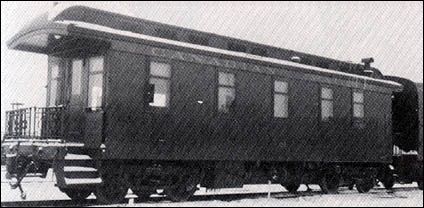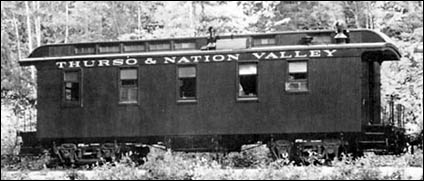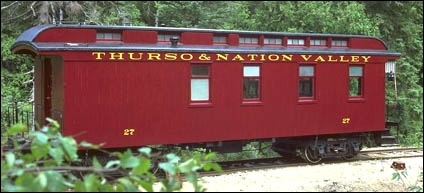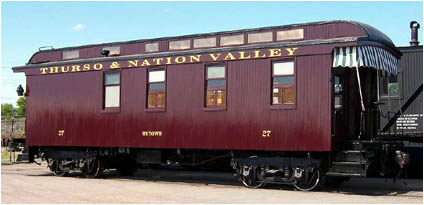Vol. 18 No. 3
March, 1988
|
Make Tomorrow Happen
|

Omer Lavallee
Corporate Historian
Emeritus
|

Superintendent's
Car No. 21
Has New
Home
|

Canadian Pacific Railway
Superintendent's car number 21.
Just before
Christmas, 1987, the Vintage Locomotive Society of Winnipeg, which operates the "Prairie Dog Central"
tourist train each summer over Canadian National tracks in the Winnipeg area, took delivery of the body of former CPR
official car No. 21.
As many old-timers will recall, No. 21 was one of a number of wooden 35-foot (10.7 metre)
superintendents's cars built in the company's shops between the turn of the century and the beginning of the First
World War.
These cars were designed to replace cabooses, which the early superintendents pre-empted as official
cars, lacking cars of their own. The story goes that an early senior officer thought that it was
"undignified" for superintendents to ride in cabooses, so the mechanical department obligingly designed a
car that was essentially a caboose body riding on passenger car trucks.
The earliest ones built had a flat roof, but later ones were built with passenger-type monitor roofs.
No. 21 was built with a flat roof but later converted to the monitor style.
INSTRUCTIONS ARE CROSSED UP
Late in the 1950's, when I was involved in the museum movement, the number of these cars in use had dwindled to two -
No. 21 and No. 22. the former was stored at Winnipeg while the latter was at Vancouver.
On behalf of the railway society in Montreal, then assembling the collection of engines and cars now stored at
Delson, Quebec, I asked the vice-president, the late George H. Baillie, if one of these cars cold be
withheld from scrapping pending the establishment of what would become the Canadian Railway Museum.
Mr. Baillie agreed and issued the necessary instructions, but in those dear dead days before electronic mail, the
instructions were crossed up. Vancouver scrapped No. 22, thinking that No. 21 was being kept. Winnipeg wrote off No.
21 assuming No. 22 was being preserved.
While No. 22 was broken up, the body of No. 21 was sold to some forestry people in Manitoba and taken to Hadashville
on the Greater Winnipeg Water District Railway, where it remained for the next quarter century.
Some years ago, the Vintage society people became aware of No. 21 and kept an eye on it. When the forestry group
declared it surplus late last year, a request for the car to be turned over to the Vintage society for preservation
was granted.
During the week before Christmas, the body of No. 21 was moved by highway to Winnipeg, then placed on a pair of
archbar trucks and put into covered storage.
During its long stay at Hadashville, the exterior walls of the car were re-sheathed, with the windows
being blocked up. Otherwise, the body is in good condition and the interior remains intact. The Society intends to
use its covered work area to restore the car to its operating condition.
My role in this is to ask our readers' assistance in providing information, anecdotes, or loan of photographs of
car No. 21 from the period that it was in operation, to add to the group's documentation.
Such material should be addressed to Gordon Younger, Vintage Locomotive Society PO Box 217 St. James PO Winnipeg
Manitoba RJ3 3R4.
In the same vein, one of these cars, No. 53, was used as a pay car on the Kenora Division in the 1920s and early
1930s, when the employees of that division in remote areas where banks were few and far between, were paid in cash.
LOOKING FOR INFORMATION
Although I realize that this car was removed from service well over half a century ago, in view of my involvement
with pay car No. 52 in Maine in the 1940s and 1950s, I would be very interested if any of our readers had
recollections about No. 53 or its operations which could be shared with me. Just write to me in care of CP Rail News
PO Box 6042 Station A Montreal Quebec H3C 3E4.
No. 21 is not the only 35-foot official car preserved. Back in the 1920s, the company sold car No. 27
to the Thurso & Nation Valley Railway, a logging line then owned by the Singer Manufacturing Company, which
connected with the Lachute subdivision at Thurso, Quebec, on the north shore of the Ottawa River, east of Hull.
Although the 100 kilometre-long line was abandoned and dismantled last year, No. 27 was donated to the
Bytown Railway Society (BRS) in Ottawa several years ago. BRS members, through much hard work, have restored the
car to absolutely pristine condition.

Thurso & Nation Valley car number
27.

Bytown Railway Society car number
27.

Official Car 27, constructed
by the Canadian Pacific Railway in their Farnham Shops, was sold to the Thurso & Nation Valley Railway. It was
rescued and rebuilt by the Bytown Railway Society of Ottawa, Ontario, and is shown here at the National Museum of
Science and Technology - 10 Jul 2006 Photographer unknown.
This CP Rail News article is copyright
1988 by the Canadian Pacific Railway and is reprinted here with
their permission. All photographs, logos, and trademarks are the property of the Canadian Pacific Railway
Company.
|